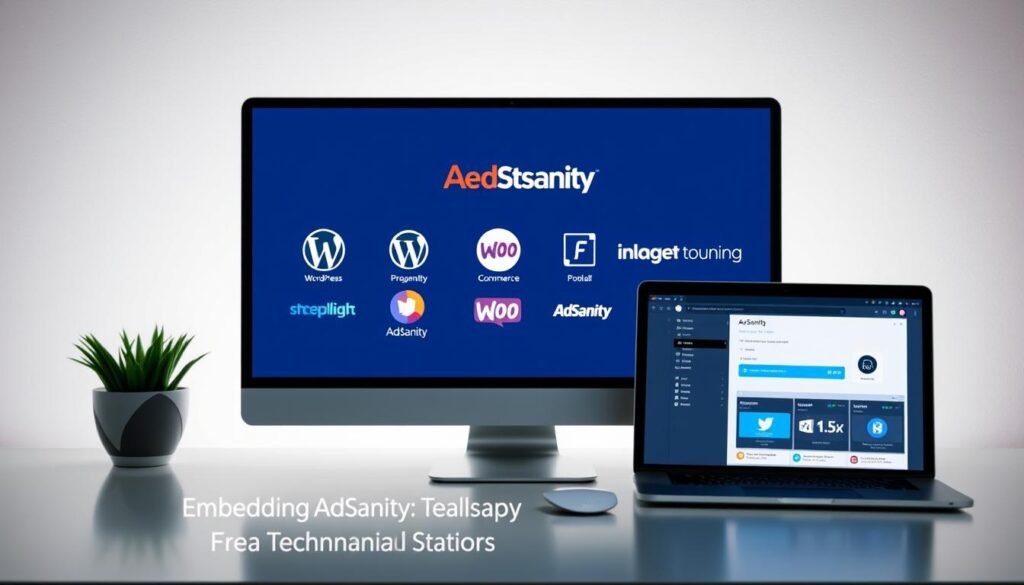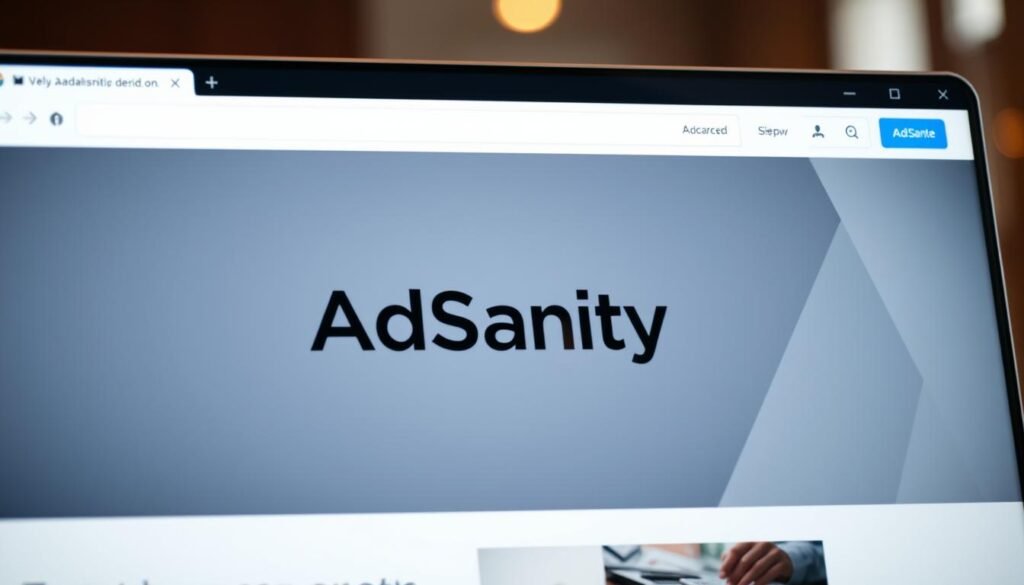Boost your website’s revenue with AdSanity’s ad embed tutorial. This guide simplifies the process, starting with logging into your dashboard. The intuitive interface uses tabs to create ads, set publish dates, and generate embed codes. Whether you’re new or experienced, this step-by-step approach makes adding ads quick and straightforward.
Create ads by selecting “Create Ad,” choosing sizes like 300×250, and uploading JPG, PNG, or GIF files. Use the Non-Widget Embed feature to copy shortcodes directly. The dashboard’s tools ensure ads display correctly without technical hurdles.
Key Takeaways
- AdSanity’s dashboard offers a tabbed interface for easy ad setup.
- Upload images in JPG, PNG, or GIF formats via the “Create Ad” section.
- Generate embed codes instantly using the Non-Widget Embeds feature.
- Schedule ads with publish dates to align with your content strategy.
- Shortcodes and template tags simplify placing ads anywhere on your site.
Understanding AdSanity: An Overview
What is AdSanity? It’s a WordPress plugin designed to simplify ad management for website owners. This tool helps embed ads seamlessly into sites using popular page builders like Beaver Builder. With AdSanity, users can choose from three main ad types: Ad Hosted On-Site, External Ad Network, or HTML5 ads, offering flexibility for any advertising strategy.
Key features include easy scheduling, customizable display options, and add-ons like the Rotating Ad Widget or Conditional Ad Appearance. These tools let users test ad placements and target audiences effectively. For example, the Rotating Ad Widget automatically cycles through ads to boost engagement without technical coding.
AdSanity’s drag-and-drop interface works smoothly with page builders, making it user-friendly even for beginners. Benefits include:
- Streamlined ad scheduling and management
- Improved ad performance tracking
- Design flexibility with no-code customization
Whether optimizing revenue or enhancing user experience, AdSanity’s integration ensures ads load quickly without slowing site performance. Website owners gain full control over where and when ads appear, maximizing visibility without disrupting visitor experience.
Setting Up Your AdSanity Account
Starting with AdSanity installation is straightforward. Begin by visiting the AdSanity website and creating an account. Use your email to register, then log in to access your dashboard. The first step ensures you’re ready to manage ads effectively.
- Click the Create Ad button on your dashboard. This opens the setup panel.
- Input your ad’s title, select size options, and upload visuals. Add your URL destination for ad links.
- Use the scheduling tools to set publish dates and choose ad groups for organization.
- Review settings and generate your embed code. Save it for later use in website integration.
Pro tip: Double-check ad parameters before saving. A well-configured ad layout reduces errors later.
AdSanity installation requires attention to detail. Each step from account creation to code retrieval builds the foundation for smooth ad display. Need help? The support team offers live chat for instant guidance.
Embedding AdSanity: Technical Essentials
AdSanity’s Supported Platforms and Plugins form the backbone of its integration flexibility. Start by ensuring your site meets core requirements: WordPress 5.6+, PHP 7.4+, and MySQL 5.7+ for basic use. For best performance, upgrade to WordPress 6+, PHP 8, and MySQL 8.

- Supported Platforms: Native compatibility with Beaver Builder simplifies ad placement. Drag-and-drop modules like Single Ad, Ad Group, and Random Placement work seamlessly in Beaver Builder layouts.
- Plugins: The Rotating Ad Widget add-on extends functionality, enabling timed ad rotations. This plugin syncs with core features to enhance customization.
Ad image formats must match predefined sizes to avoid scaling errors. Hosts must support PHP 7.4+ and MySQL 5.7+ to prevent conflicts. Check server configurations before installation.
WordPress.com users on Business plans gain full access, while self-hosted sites enjoy plugin flexibility. Test ad units in staging environments to avoid live-site disruptions.
Designing Custom Ad Displays
Creating custom ad displays is key to making your ads match your site’s style. With AdSanity, you can design ads that look great and fit naturally with your content. Here’s how to start:
- Use static images to upload your own visuals, ensuring colors and themes align with your brand.
- Set up rotating ads to cycle through creatives, keeping visitors engaged without extra coding.
- Pick from pre-built templates for quick layouts, then tweak details like size and placement.
“A well-designed ad isn’t intrusive—it’s part of the experience.” – Design Pro Tip
Experiment with shortcodes to place ads in any spot on your page. Adjust text, buttons, or backgrounds to match your site’s palette. Try rotating ads during peak traffic times to test which styles perform best. Small changes, like spacing or hover effects, can boost click-through rates without overwhelming users.
Remember, custom ad displays work best when they feel like a natural part of your site. Test different styles, track results, and refine for better engagement and revenue!
Optimizing Ad Performance & Revenue
Boost revenue by refining how ads appear to users. A/B Testing Ad Formats lets you compare designs, placements, and colors to see what works best. Start simple: test two layouts side by side. Track which option gets more clicks over a week.
Use AdSanity’s built-in tools to split traffic between versions. For example, test a square banner vs. a horizontal strip. Check results in the analytics dashboard to see which ad formats drive higher engagement. Repeat tests monthly as user preferences shift.
- Rotate ad positions: sidebar vs. footer
- Adjust colors and text length
- Compare click-through rates (CTR) weekly
Monitor metrics like views and conversions. High view counts but low clicks mean the ad isn’t compelling. Tools like Google Analytics can pair with AdSanity to track user journeys. Focus on formats that convert visitors into customers, not just clicks.
“Small changes in ad design can double revenue. Test relentlessly.”
Keep testing even after finding a winner. User behavior changes, so regular A/B Testing Ad Formats ensures ads stay effective. Prioritize data over guesswork to grow earnings sustainably.
Integrating with Your Website Seamlessly
Smooth ad placement doesn’t mean sacrificing site flow. Use AdSanity’s flexible tools to merge ads into headers, footers, or sidebars without disrupting user navigation. Page builders like Beaver Builder simplify this process, letting you drag-and-drop ad modules into any layout section.
Try these steps for effortless setup:
- Identify high-traffic zones like blog sidebars or product pages
- Use Beaver Themer to place ads in header/footer areas without code
- Test ad visibility on mobile and desktop views

Balance matters. Avoid overcrowding content areas—leave 1-2 ad spots per page for better user experience. For example, place one above-the-fold and another below key content.
“Users notice when ads feel natural, not forced,” says digital marketing expert Sarah Chen.
Check Beaver Builder’s documentation for template-specific placement guides. Remember: seamless integration means ads enhance revenue without making visitors aware they’re viewing ads.
Troubleshooting Common Embed Issues
Encountering display glitches after setting up AdSanity? Resolving display problems starts with identifying the root cause. Let’s break down fixes for five frequent scenarios:
| Issue | Cause | Solution |
|---|---|---|
| Ads redirecting to 404 pages | WordPress permalink misconfiguration | Go to Settings > Permalinks > Save Changes without edits |
| Ads not rotating | Lazy loading enabled or missing featured images | Disable lazy loading; add featured images to all ads |
| External ads not showing | Incorrect code integration | Verify ad service settings and code placement |
| Format inconsistencies | Uncertified formats or wrong tags | Confirm site certification and use device-specific tags |
| Blank ad spaces | Incorrect ad tag placement | Validate tags match the chosen placement and format |
For persistent errors, start by checking the ad’s featured image status. Many rotation issues stem from missing visuals. If ads still misbehave after fixes, try clearing browser caches. Remember: resolving display problems often requires checking both backend settings and front-end implementations.
- Always test ads in incognito mode to bypass caching
- Use AdSanity’s built-in preview tools for real-time checks
Advanced Customization Techniques
Take your AdSanity setup beyond basics with expert-level tweaks. Dynamic ad content lets ads change based on user behavior—like showing seasonal offers during holidays or geo-targeted promotions. Use advanced shortcodes to insert variables like {user_location} or {time_of_day} directly into ad code.
- Dynamic content: Pair with analytics tools to trigger ads based on visitor history.
- Advanced shortcodes: Adjust padding, colors, or CTA buttons using AdSanity’s shortcode parameters.
- Conditional displays: Install add-ons like AdSanity Conditional Rules to hide ads for mobile users or show premium placements to returning visitors.
Experiment with A/B testing different layouts using AdSanity’s built-in variants. For example, rotate two ad designs weekly to see which boosts clicks. Always review the AdSanity dashboard after changes to track performance shifts. Combining these methods creates personalized ad experiences that stand out to users.
how to embed adsanity on my website
Follow this Step-by-Step Implementation Guide to add AdSanity ads to your site quickly. Start by logging into your AdSanity dashboard and selecting the “Create Ads” page. Here, choose your ad type, set dimensions matching your site’s layout, and upload artwork. Schedule your ad to run and click “Generate Embed Code.”
| Step | Action | Note |
|---|---|---|
| 1 | Navigate to the AdSanity dashboard | Locate the “Create Ads” button |
| 2 | Set dimensions to match ad slots | 300×250 or 728×90 pixels work best |
| 3 | Copy the embed code | Paste into your site’s HTML using a text editor |
Testing is key. Use tools like Beaver Builder or your CMS editor to preview ads. Ensure ads adjust on mobile by enabling responsive design in AdSanity’s settings. Avoid overcrowding pages—place ads above the fold or in sidebars for better engagement.
- Validate code placement with AdSanity’s validator tool
- Test ads across browsers (Chrome, Firefox, Safari)
- Monitor performance via the dashboard analytics
Need help? Check AdSanity’s support portal or join their Discord community for real-time advice. Consistency in following these steps ensures ads load smoothly without disrupting user experience.
Conclusion
AdSanity’s WordPress plugin simplifies ad management while boosting revenue optimization. Its lightweight design ensures fast performance, and customizable CSS classes let you style ads to match any site. Whether you’re targeting specific user roles or rotating ads dynamically, AdSanity’s tools make it easy to tailor displays without coding expertise.
With features like ad blocking detection and Google Analytics integration, AdSanity empowers data-driven decisions. Users like Syed Balkhi praise its beginner-friendly setup, while advanced users benefit from hooks and filters for plugin customization. The 14-day guarantee and 3.5-hour support response time ensure peace of mind.
Start by applying the steps from this guide to embed ads seamlessly. Explore add-ons like Weighted Ads or Conditional Display to refine strategies. Visit the help site for tutorials or open a support ticket for instant assistance. Whether you choose the Basic, Pro, or Extended license, AdSanity adapts to your goals—whether monetizing a blog or scaling a network of sites.
Test the plugin’s versatility today. Experiment with ad groups, track performance via graphical stats, and watch revenue grow. AdSanity’s flexibility ensures ads enhance user experience without compromising speed or design. Take the next step to transform your site’s monetization potential with a tool built for efficiency and growth.

